Abstract
Intercellular signaling molecules of the transforming growth factor-β (TGF-β) superfamily are required for pattern formation in many multicellular organisms. The decapentaplegic (dpp) gene of Drosophila melanogaster has several developmental roles. To improve our understanding of the evolutionary diversification of this large family we identified dpp in the grasshopper Schistocerca americana. S. americana diverged from D. melanogaster approximately 350 million years ago, utilizes a distinct developmental program, and has a 60-fold-larger genome than D. melanogaster. Our analyses indicate a single dpp locus in D. melanogaster and S. americana, suggesting that dpp copy number does not correlate with increasing genome size. Another TGF-β superfamily member, the D. melanogaster gene 60A, is also present in only one copy in each species. Comparison of homologous sequences from D. melanogaster, S. americana, and H. sapiens, representing roughly 900 million years of evolutionary distance, reveals significant constraint on sequence divergence for both dpp and 60A. In the signaling portion of the dpp protein, the amino acid identity between these species exceeds 74%. Our results for the TGF-β superfamily are consistent with current hypotheses describing gene duplication and diversification as a frequent response to high levels of selective pressure on individual family members.
Similar content being viewed by others
References
Arora K, Levine MS, O'Conner MB (1994) The screw gene encodes a ubiquitously expressed member of the TGF-β family required for specification of dorsal cell fates in the Drosophila embryo. Genes Dev 21:2588–2601
Bentley D, Keshishian H, Shankland M, Toroian-Raymond A (1979) Quantitative staging of embryonic development of the grasshopper Schistocerca nitens. J Embryol Exp Morphol 54:47–74
Chomczynski P, Saachi N (1987) Single step method of RNA isolation by acid guanidinium thiocyanate-phenol-chloroform extraction. Anal Biochem 162:156–159
Echelard Y, Epstein DJ, St-Jacques B, Shen L, Mohler J, McMahon JA, McMahon AP (1993) Sonic hedgehog, a member of a family of putative signalling molecules, is implicated in the regulation of CNS polarity. Cell 75:1417–1430
Field KG, Olsen GJ, Lane DJ, Giovanni SJ, Ghiselin MT, Raff EC, Pace NR, Raff RA (1988) Molecular phylogeny of the animal kingdom. Science 239:748–753
Hennig W (1981) Insect phylogeny. John Wiley & Sons, New York
Irish VF, Gelbart WM (1987) The haplo-insufficient region of the decapentaplegic gene is required for dorsal-ventral patterning of the Drosophila embryo. Genes Dev 1:868–879
Kingsley DM (1994) The TGF-β superfamily: new members, new receptors, and new tests of genetic function in different organisms. Genes Dev 8:133–146
Li W-H (1983) Evolution of duplicate genes and pseudogenes. In: Nei M, Koehn RK (eds) Evolution of genes and proteins. Simmer Associates, Sunderland, MA, pp 14–37
Loh EY, Elliott JF, Cwirla S, Lanier LL, Davis M (1989) Polymerase chain reaction with single sided specificity: analysis of T cell receptor delta chain. Science 243:217–222
Massagué J (1990) The transforming growth factor-β family. An Rev Cell Biol 6:597–641
Newfeld SJ, Smoller DA, Yedvobnick B (1991) Interspecific comparison of the unusually repetitive Drosophila locus mastermind. J Mol Evol 32:415–420
Newfeld SJ, Schmid AT, Yedvobnick B (1993) Homopolymer length variation in the Drosophila gene mastermind. J Mol Evol 37:483–495
Padgett RW, St Johnston RD, Gelbart WM (1987) A transcript from a Drosophila pattern gene predicts a protein homologous to the transforming growth factor beta gene family. Nature 325:81–84
Padgett RW, Wozney JM, Gelbart WM (1993) Human BMP sequences can confer normal dorsal-ventral patterning in the Drosophila embryo. Proc Natl Acad Sci USA 90:2905–2909
Panganiban GEF, Rashka KE, Neitzel MD, Hoffman MF (1990) Biochemical characterization of the Drosophila dpp protein, a member of the transforming growth factor β family of growth factors. Mol Cell Biol 10:2669–2677.
Patel NH, Ball EE, Goodman CS (1992) Changing role of even-skipped during the evolution of insect pattern formation. Nature 357:339–342
Sambrook J, Fritsch E, Maniatis T (1989) Molecular cloning: a laboratory manual (2nd ed). Cold Spring Harbor Laboratory Press, Cold Spring Harbor, NY
Sampath TK, Rashka KE, Doctor JS, Tucker RF, Hoffman MF (1993) Drosophila TGF-β superfamily proteins induce endochondrial bone formation in mammals. Proc Natl Acad Sci USA 90:6004–6008
Segal D, Gelbart WM (1985) Shortvein, a new component of the decapentaplegic gene complex in Drosophila melanogaster. Genetics 109:119–143
Smith RF, Smith TF (1990) Automatic generation of primary sequence patterns from sets of related protein sequences. Proc Natl Acad Sci USA 87:118–122
Snow PM, Zinn K, Harrelson AL, McAllister L, Schilling J, Bastiani MJ, Makk G, Goodman CS (1988) Characterization and cloning of fasciclin I and fasciclin II glycoproteins in the grasshopper. Proc Natl Acad Sci USA 85:5291–5295
Spencer FA, Hoffman FM, Gelbart WM (1982) Decapentaplegic: a gene complex affecting morphogenesis in Drosophila melanogaster. Cell 28:451–461
St. Johnston RD, Hoffman FM, Blackman RK, Sejal D, Grimaila R et al. (1990) Molecular organization of the decapentaplegic gene in Drosophila melanogaster. Genes Dev 4:1114–1127
Wharton KA, Thomsen GH, Gelbart WM (1991) Drosophila 60A gene, another transforming growth factor beta family member, is closely related to human bone morphogenetic proteins. Proc Natl Acad Sci USA 88:9214–9218
Wilmore PJ, Brown AK (1975) Molecular properties of orthopteran DNA. Chromosoma 51:337–345
Wozney JM, Rosen V, Celeste AJ, Mitsock LM, Whitters MJ, Driz RW, Hewick RM, Wang EA (1988) Novel regulators of bone formation: molecular clones and activities. Science 242:1528–1534
Author information
Authors and Affiliations
Rights and permissions
About this article
Cite this article
Newfeld, S.J., Gelbart, W.M. Identification of two Drosophila TGF-β family members in the grasshopper Schistocerca americana . J Mol Evol 41, 155–160 (1995). https://doi.org/10.1007/BF00170667
Received:
Accepted:
Issue Date:
DOI: https://doi.org/10.1007/BF00170667




